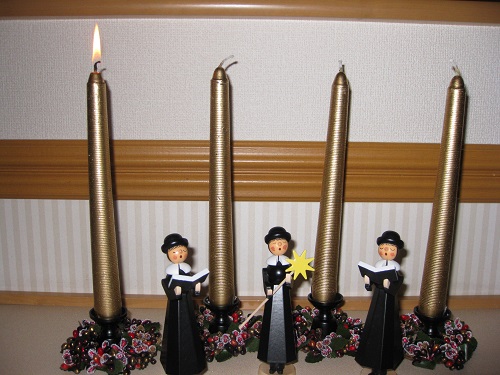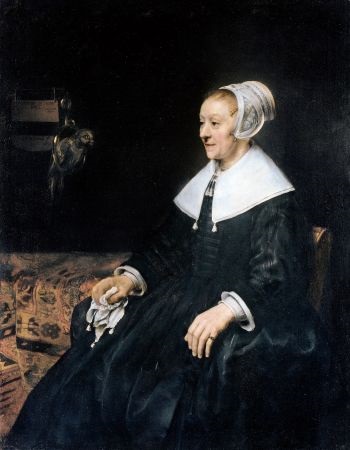I can’t help it. Standing in front of numerous painted figurines set up in a Nagoya department store, I can’t suppress my laughter. Trying to hold it in prompts tears. An unsolicited mess. After all these weeks, maybe the journey is getting to me.
In front of me stand exquisitely carved and hand-painted carolers in various sizes, some more than 30 cm tall. Along with nutcrackers and nativity-themed scenes of all sizes from the Association of Craftspeople and Toymakers of the Erzgebirge, these figurines remind me of my ancestors: white-collared, black robed Anabaptists.
Menno Simons and his followers setting the world on fire (or rather, it was the other way around) with their counter-revolution to Luther’s Reformation.
Though I am Canadian, my antecedents are Russian Mennonite (via Holland and the Vistula Delta), part of a sect which never stayed too long in any place, making for somewhat shallow roots. Always, no matter how cozy, the tacit cultural understanding was and remains: This place is not my home.
Now, having wandered so far west of Canada, a home my grandparents adopted in the 1920s, these carvings stare me in the face and remind me. You might even call it Menno mono no aware (the transience of things), an idea I find bizarre and insanely funny.
Of course, I’m laughing discretely. I’m hoping that anyone who finds it a little odd to see a foreign woman quietly laughing and dabbing her eyes in front of a Christmas display will—as Japanese people usually do—ignore the incident. But no. A beautifully groomed man about my age appears at my side, bows and asks, “May I help you?”
O heavens. Where do I start? Not that many hours ago I was in a semantic tangle with a ticket agent. Explanations? No, not possible. I wipe my eyes. Okay, now. This is serious. Get to the point and get rid of this guy.
Do you speak English?
Yes, I do. I see you are enjoying these carvings. They are all hand made in Germany.
Yes. I recognize them. That’s why I am laughing. I have come all the way to Japan, and here are my ancestors to greet me. For some reason I find that very funny.
And where are you from?
I’m from Canada. I live near Vancouver.
Naturally, he is curious about the ancestors. And thus begins a delightful conversation which moves on to my present journey and his recent buying trip to the German workshops where the figurines are carved. He guides me around the various Christmas-themed items on display, shows me their subtle intricacy, their detailed perfection.
I pick up one of the 10-centimetre carollers with a song book in his hands and am stunned to read hand-painted words of Stille Nacht (Silent Night) on the miniscule pages. Not only that, the musical notation is perfect, too.
Eventually I feel I must apologize for taking up this gentleman’s time as he’s probably on commission. I express regret that I cannot purchase anything as I have no room. I am travelling with one carry-on suitcase.
This fact always surprises men, and he is no exception. How do you do this? Please, tell my wife. However, he reassures me. It’s not busy, he’s enjoyed our conversation and he wishes me a safe journey. We bow our good-byes and part.
But the little white-ruffed rascals haunt me. Before long I’m back and buy the small set. They cost so much that I get a voucher (I know that word now) for a tax rebate.
I rationalize the extravagance from every angle. I buy one Christmas ornament every year. I won’t have time to look for something after I get back to Canada. Everything will be picked over; nothing will be quite like this. Somehow I’ll squeeze the box into the suitcase, or I’ll buy a bigger purse.
Only several years later do I connect the dots. One evening near Christmas a line from the German carol sparks something in my mind differently than it ever has before: … o wie lacht Lieb aus deinem gottlichen Mund…. (Oh, how love laughs from your godly mouth—though no English version even attempts that poetic line.)
Now as I grapple with the ending to this post, illumination comes full circle, makes its way back to the little Anabaptist carolers. Now I understand why I was laughing to meet my ancestors so far from home in Nagoya. Now I recognize who was there with me—laughing, too.


